SEO Strategies for Bloggers: Proven Tactics for 2025 Success


Bloggers are chasing higher Google rankings and audience growth, but the rules for SEO change fast. You might think stuffing keywords everywhere is the trick. Except, that old playbook is nearly obsolete. Backlinko found that shorter, more descriptive URLs now consistently outrank complex web addresses in search results. So if you want to stand out in 2025, it is not just about what you write. It is about how you structure, link, and optimize every element of your blog for both readers and search engines.
Table of Contents
- Choosing The Right Keywords For Your Blog
- Creating Optimized And Engaging Blog Content
- Technical SEO Tactics Every Blogger Needs
- Link Building And Promotion For Lasting Results
Quick Summary
| Takeaway | Explanation |
|---|---|
| Focus on Search Intent | Understand the user's underlying motivation for queries, categorizing keywords into informational, navigational, transactional, and commercial to create relevant content. |
| Strategic Keyword Placement | Integrate selected keywords naturally across titles, meta descriptions, headers, and body content to enhance relevance while avoiding keyword stuffing. |
| Optimize Content Structure | Craft compelling content with captivating headlines, clear subheadings, and scannable formatting to improve reader engagement and reduce bounce rates. |
| Implement Technical SEO | Prioritize website performance, URL and header optimization, and advanced techniques like schema markup to enhance search engine visibility and user experience. |
| Quality Over Quantity in Link Building | Pursue high-quality backlinks from reputable sources through authentic content and strategic outreach rather than focusing on the sheer number of links. |
Choosing the Right Keywords for Your Blog
Keyword selection represents the strategic foundation of successful SEO strategies for bloggers. When done correctly, keyword research transforms your content from random digital noise into targeted communication that attracts your ideal audience.
Understanding Search Intent
Keyword research goes far beyond simply identifying popular search terms. The core of effective keyword selection lies in comprehending search intent - the underlying motivation driving a user's query. According to AIOSEO, keywords typically fall into four primary categories: informational, navigational, transactional, and commercial.
- Informational Keywords: Users seeking knowledge or answers
- Navigational Keywords: Searches aimed at finding a specific website
- Transactional Keywords: Queries with purchase or action intent
- Commercial Keywords: Research-oriented searches before making a purchase
By aligning your content with these specific intent categories, you create more relevant and engaging blog posts that precisely match what readers are searching for online.
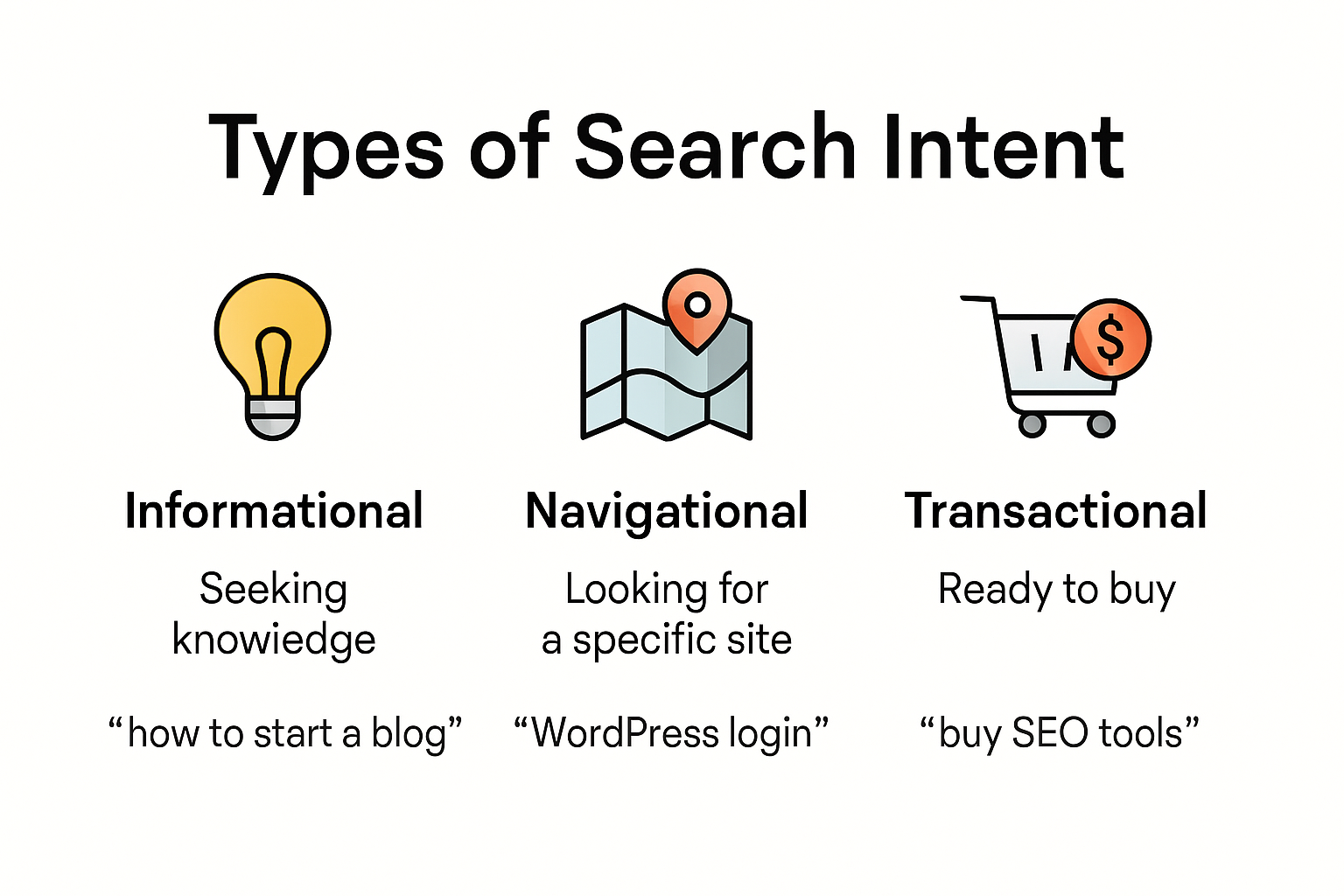
Strategic Keyword Placement
Selecting keywords isn't just about discovering them - it's about strategic implementation. Research from Siege Media suggests prioritizing keywords based on potential return on investment (ROI) rather than pure search volume.
Effective keyword placement involves integrating terms naturally across multiple content elements:
- Titles: Include primary keywords
- Meta Descriptions: Incorporate secondary keywords
- Headers: Use related long-tail keywords
- Body Content: Distribute keywords contextually
Avoid the common pitfall of keyword stuffing. Modern search algorithms prioritize natural, reader-friendly content that provides genuine value. Instead, focus on creating comprehensive, well-researched articles that organically incorporate your target keywords.
Advanced Keyword Research Techniques
Successful bloggers utilize sophisticated keyword research techniques that go beyond basic volume metrics. Look for opportunities in:
- Long-tail Keywords: More specific, less competitive phrases
- Question-based Keywords: Directly addressing user queries
- Semantic Keywords: Related terms that expand content depth
Utilize tools that provide comprehensive keyword insights, analyzing not just search volume but also competition level, potential traffic, and user engagement metrics. This approach transforms keyword research from a mechanical task into a strategic content planning process.
Remember, the ultimate goal isn't just ranking higher - it's connecting meaningfully with your target audience by understanding and addressing their specific informational needs.
Creating Optimized and Engaging Blog Content
Blog content represents the heartbeat of your digital presence. Creating optimized and engaging content requires a strategic approach that balances reader experience with search engine requirements.
Crafting Compelling Content Structure
Successful blog content starts with understanding how readers consume information online. According to AIOSEO, creating high-quality content involves more than just writing - it requires deliberate structural considerations. A well-organized blog post guides readers seamlessly through your narrative while signaling relevance to search engines.
Key Content Structure Elements:
- Captivating Headlines: Create titles that spark curiosity
- Clear Subheadings: Break content into digestible sections
- Scannable Formatting: Use short paragraphs and bullet points
The goal is to make your content immediately accessible. Readers should understand the core message within seconds of landing on your page. This approach reduces bounce rates and signals content quality to search algorithms.
Optimizing Content for Search Intent
The HOTH emphasizes that content optimization goes beyond keyword placement. Modern SEO demands a holistic approach that directly addresses user needs. This means creating content that thoroughly answers reader questions while maintaining a natural, engaging tone.Strategies for matching search intent include:
- Question-Driven Content: Directly address common user queries
- Comprehensive Coverage: Provide in-depth exploration of topics
- Visual Engagement: Incorporate relevant images, infographics, and multimedia
A flat site architecture becomes crucial in this context. By ensuring all blog pages are easily accessible - ideally within one click from the homepage - you improve both user navigation and search engine crawlability.
Advanced Content Optimization Techniques
Beyond basic SEO tactics, advanced content optimization requires a nuanced approach. Internal linking emerges as a powerful strategy for distributing link equity and improving overall site structure. Strategic internal links help search engines understand content relationships while providing readers with additional valuable resources.

Consider these advanced optimization techniques:
- Contextual Internal Linking: Connect related blog posts naturally
- Multimedia Integration: Use images with descriptive alt text
- Content Depth: Create comprehensive, authoritative pieces
Remember that true content optimization is not about gaming search algorithms but providing genuine value. Each piece of content should solve a problem, answer a question, or offer unique insights that genuinely help your target audience.
The intersection of user experience and technical SEO creates truly remarkable blog content - content that ranks well and genuinely connects with readers.
Technical SEO Tactics Every Blogger Needs
Technical SEO represents the foundation of your blog's search engine performance. While content quality remains paramount, understanding and implementing strategic technical optimizations can significantly elevate your blog's visibility and ranking potential.
Website Performance Optimization
Website speed and responsiveness are critical technical SEO elements in 2025. According to Black Hat World, search engines increasingly prioritize websites that deliver exceptional user experiences through rapid loading times and mobile compatibility.
Critical Performance Metrics:
- Page Load Speed: Aim for under 3 seconds
- Mobile Responsiveness: Ensure seamless display across devices
- Core Web Vitals: Optimize loading, interactivity, and visual stability
Implementing technical optimizations like image compression, browser caching, and minimizing server response times directly impacts your blog's search engine rankings. These technical improvements signal to search algorithms that your website provides a superior user experience.
Strategic URL and Header Optimization
AIOSEO highlights the importance of strategic header tag and URL optimization. Header tags (H1-H6) serve dual purposes: structuring content for readers and providing context for search engines.Key optimization strategies include:
- Concise URL Structures: Use short, keyword-rich URLs
- Hierarchical Header Usage: Implement headers logically
- Keyword Integration: Naturally incorporate target keywords in headers
Advanced Technical SEO Techniques
Beyond basic optimizations, advanced technical SEO requires a comprehensive approach. Implement these sophisticated tactics to enhance your blog's search engine performance:
- Schema Markup: Provide structured data for rich search results
- XML Sitemap: Ensure comprehensive website indexing
- SSL Security: Implement HTTPS for improved trust signals
Technical SEO is not a one-time task but an ongoing process of refinement. Regular audits, performance monitoring, and adaptive strategies ensure your blog remains competitive in the dynamic digital ecosystem.
Remember, technical SEO bridges the gap between exceptional content and search engine visibility. By mastering these tactics, you transform your blog from a passive online presence to an actively discoverable and engaging digital resource.
Link Building and Promotion for Lasting Results
Link building represents the critical backbone of sustainable SEO strategies for bloggers. In 2025, successful link acquisition goes far beyond simple quantity metrics and demands a sophisticated, strategic approach that prioritizes quality and relevance.
Understanding Modern Link Building
Semrush reveals that contemporary link building requires a multifaceted strategy focused on earning high-quality backlinks through genuine value creation. The days of manipulative link schemes are long gone - modern search algorithms demand authentic, contextually relevant connections.Effective Link Building Principles:
- Authority Matters: Prioritize links from reputable websites
- Contextual Relevance: Ensure links align with content themes
- Natural Acquisition: Focus on earning links through exceptional content
Successful bloggers understand that each backlink serves as a vote of confidence from one website to another. Search engines interpret these signals as indicators of content credibility and expertise.
Strategic Link Acquisition Techniques
Search Engine Land emphasizes that link quality trumps quantity in modern SEO practices. Strategic link acquisition involves creating linkable assets that naturally attract attention from industry authorities.Powerful link acquisition strategies include:
- Guest Posting: Contribute expert content to respected industry platforms
- HARO (Help a Reporter Out): Provide expert quotes for journalistic pieces
- Collaborative Content: Create comprehensive research or industry reports
These techniques transform link building from a mechanical process into a relationship-driven approach that generates genuine professional connections.
Advanced Promotion and Analytics
Coalition Technologies suggests leveraging advanced analytics to identify trending topics and content formats that naturally attract backlinks. Modern bloggers must become strategic content architects who understand precisely what makes content shareable and link-worthy.Key promotional tactics:
- Content Trend Analysis: Monitor industry content performance
- Social Media Amplification: Share content strategically
- Targeted Outreach: Connect with industry influencers
Remember that sustainable link building is a long-term investment. Each high-quality backlink incrementally builds your blog's authority, creating a compounding effect that improves search visibility over time.
Successful link building in 2025 requires creativity, persistence, and a genuine commitment to producing extraordinary content that others naturally want to reference and share.
Frequently Asked Questions
What are the best SEO strategies for bloggers in 2025?
To succeed in 2025, bloggers should focus on understanding search intent, optimizing content structure, implementing technical SEO best practices, and prioritizing quality link building. These strategies create valuable content that resonates with both readers and search engines.
How do I choose the right keywords for my blog?
Start by understanding search intent, categorizing keywords into informational, navigational, transactional, and commercial. Use advanced keyword research techniques to identify long-tail and question-based keywords that align with your audience's needs for more targeted traffic.
What is the importance of content structure in SEO?
A clear content structure improves user experience by making articles easy to read and navigate. Using compelling headlines, clear subheadings, and scannable formatting helps keep readers engaged, reduces bounce rates, and signals relevance to search engines.
How can I improve my blog's technical SEO?
To enhance technical SEO, focus on website performance optimization (like page loading speed and mobile responsiveness), strategic URL and header tag optimization, and advanced techniques such as schema markup and maintaining an XML sitemap. Regular audits will help keep your blog competitive.
Ready to Transform Your Blog’s SEO Results?
You just learned that staying ahead in 2025 means understanding search intent, creating optimized content, and streamlining technical SEO. But here’s the real challenge: Most bloggers and small business owners struggle to keep up with keyword research, build a strategic content plan, and publish at the pace needed to truly outrank competitors. The work can feel overwhelming and time-consuming, all while you risk falling behind the competition.

Stop letting SEO complexity slow your growth. With BabyLoveGrowth.ai, you can automate everything from deep keyword analysis to a custom 30-day content roadmap to full article creation—all tailored to your unique business. Our AI-driven platform brings the proven tactics from this article to life, giving you:
- Smart business and competition analysis
- Hands-off, fully optimized content generation
- Clear plans that let you focus on your passion, not on research and writing
If you’re ready to make your blog a top performer in Google search and stop guessing what works, visit BabyLoveGrowth.ai right now. Give your content a powerful edge and see faster, real results. The sooner you start, the sooner you can watch your organic traffic soar.
Smart SEO,
Faster Growth!
Most Read Articles
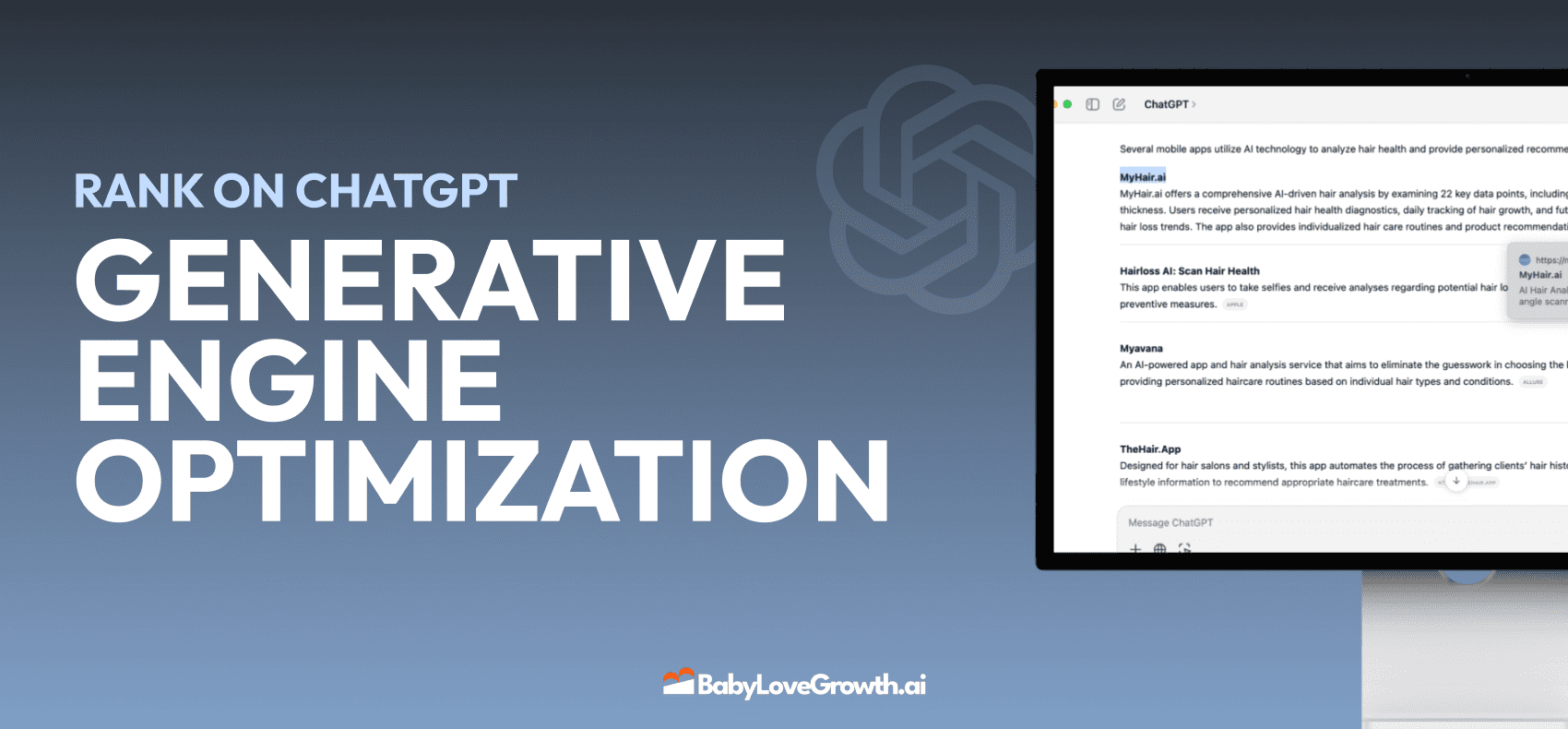
Generative Engine Optimization (GEO)
Learn how Generative Engine Optimization (GEO) helps your content rank in AI search engines like ChatGPT and Google AI. This comprehensive guide explains the differences between SEO and GEO, why it matters for your business, and practical steps to implement GEO strategies for better visibility in AI-generated responses.
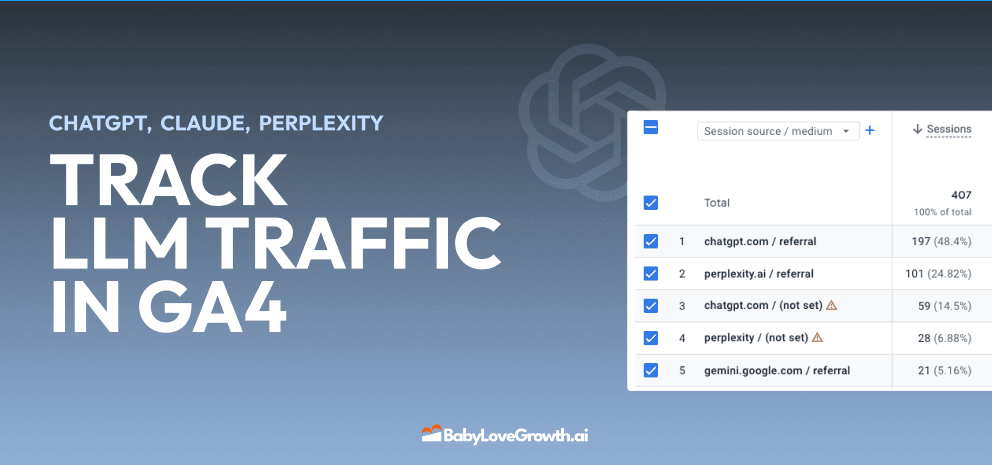
Track LLM Traffic in Google Analytics 4 (GA4)
Learn how to track and analyze traffic from AI sources like ChatGPT, Claude, Perplexity, and Google Gemini in Google Analytics 4. This step-by-step guide shows you how to set up custom filters to monitor AI-driven traffic and make data-driven decisions for your content strategy.
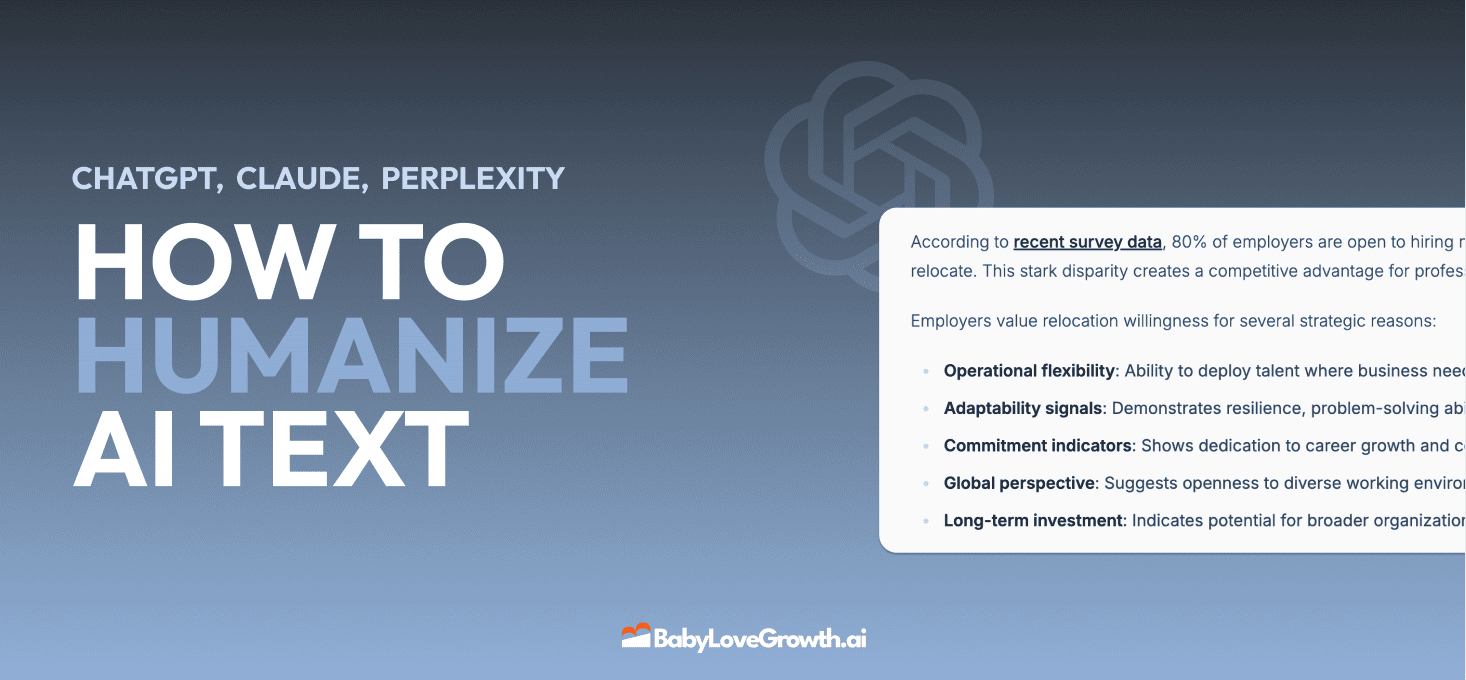
How to Humanize AI Text with Instructions
Learn practical techniques to make AI-generated content sound more natural and human. This guide covers active voice, direct addressing, concise writing, and other proven strategies to transform robotic text into engaging content.
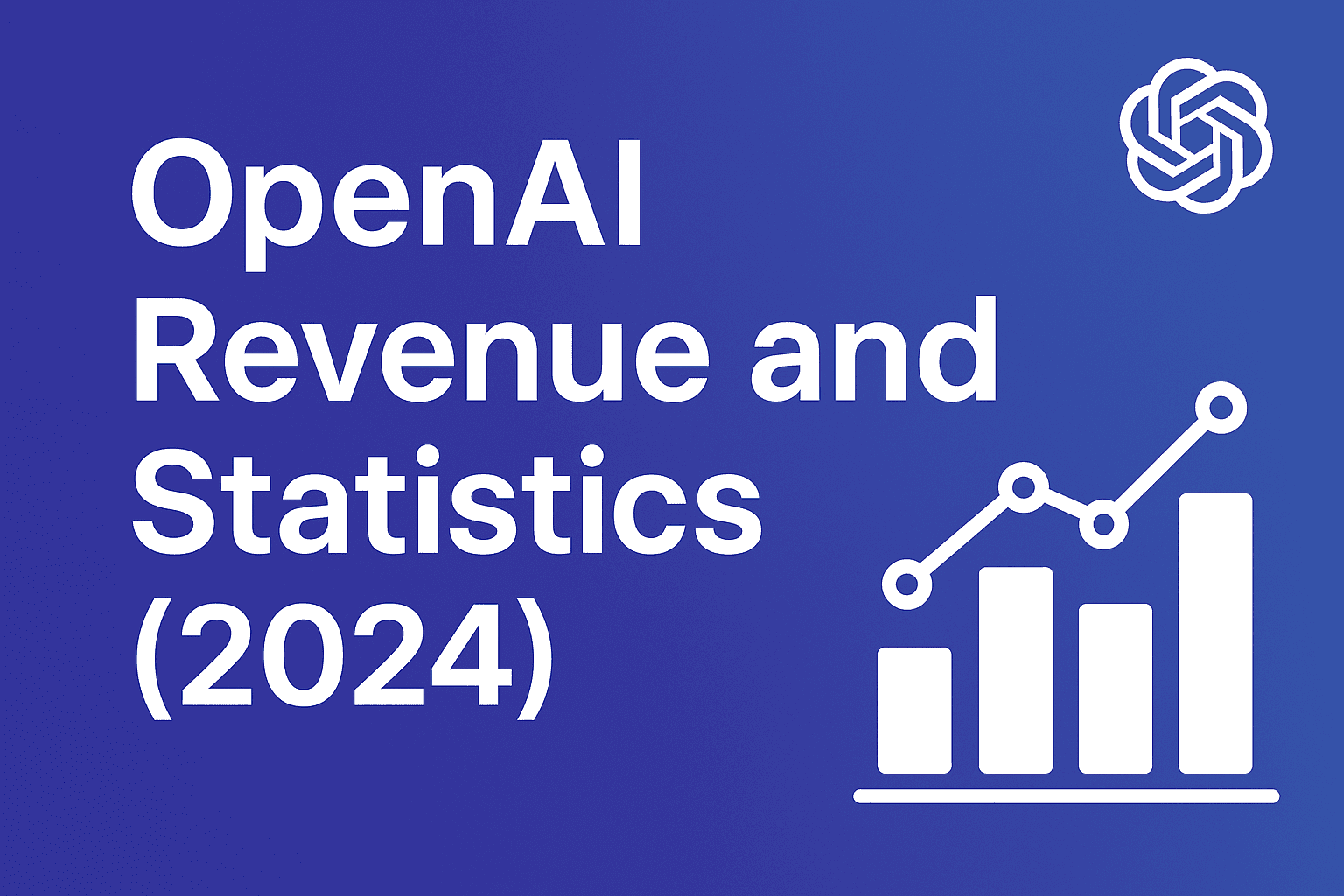
Open AI Revenue and Statistics (2024)
Comprehensive analysis of OpenAI financial performance, user engagement, and market position in 2023. Discover key statistics including $20B valuation, $1B projected revenue, and 100M+ monthly active users.